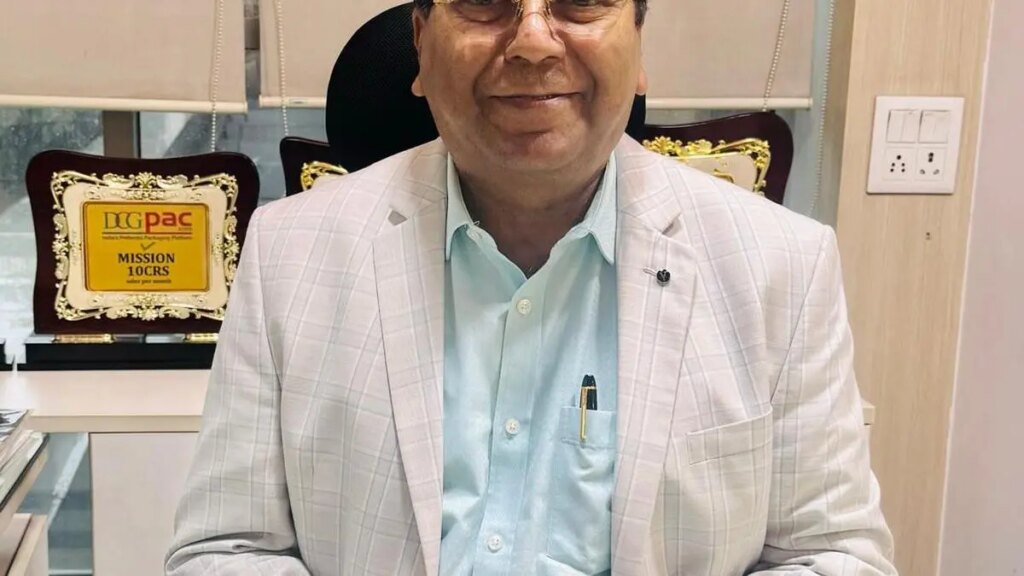
Packaging as a Service: DGCpac Launches Innovative Rental Model for Sustainable Solutions
Packaging as a Service: DGCpac Launches Innovative Rental Model for Sustainable Solutions
Published on April 18, 2025
DGCpac’s new Packaging as a Service model allows businesses to rent reusable packaging materials, advancing sustainability goals while reducing capital expenditure. (Image: Representative)
Table of Contents
DGCpac, one of India’s leading packaging materials supply platforms, is set to revolutionize the industry with its innovative Packaging as a Service business model. The company plans to offer packaging materials for rent and launch a dedicated Product as a Service (PaaS) platform, according to Suresh Bansal, Founder and CEO. This pioneering approach comes at a time when sustainability concerns are pushing businesses to rethink traditional packaging practices. The Packaging as a Service concept represents a significant shift from the conventional purchase-and-dispose model to a more environmentally conscious rental system for reusable packaging materials.
Introducing Packaging as a Service
The new Packaging as a Service unit will allow customers to rent packaging materials that can be reused multiple times, rather than purchasing single-use options. This innovative business model addresses growing environmental concerns while offering financial benefits to businesses that may not want to invest in expensive packaging assets.
Key Features of DGCpac’s Packaging as a Service Model
- Rental System: Customers can rent instead of purchasing packaging materials
- Reusable Items: Focus on pallets, trays, and specially-created automobile kits
- Subscription Model: Monthly payment structure including service charges
- Reduced Capital Investment: Eliminates need for upfront investment in packaging
- Sustainability Focus: Aligns with the three Rs – reduce, reuse, recycle
“On a sustainability basis, you follow three Rs — reduce, reuse and recycle. We are focusing on the sustainability goals for us and our corporate customers,” explained Bansal. The Packaging as a Service model particularly targets reusable long-term packaging items such as pallets and trays, as well as specially-created automobile kits that can be used repeatedly.
“Customers can buy a product from the company and make the payment, including the service charges, every month. They need not invest in capital. This is mainly for reusable long-term packaging items. It can be for equipment or it can be for assets. However, it is not for consumables.”
DGCpac’s Ambitious Growth Strategy
The introduction of the Packaging as a Service model is part of what Bansal describes as “DGCpac 3.0” — an ambitious growth strategy aimed at expanding the company’s operations tenfold within the next five years. Currently generating revenues of approximately ₹150 crore, DGCpac targets reaching ₹1,500 crore by 2030 through technological innovation and market expansion.

DGCpac’s ambitious growth strategy includes AI enhancement and expansion of its Packaging as a Service platform to reach new customer segments. (Image: Representative)
“DGCpac is embarking on its 3.0 journey, targeting to grow 10x from its current ₹150 crore revenue in the next five years. It will be fully artificial intelligence-enhanced — a new platform with new technology reaching out to a new set of customers and markets. We have learned a lot of lessons in DGCpac 2.0 and will use them,” Bansal explained during an online interaction with the press.
The company’s growth strategy is built on three key pillars: innovative service models like Packaging as a Service, technological enhancement through AI integration, and market expansion both domestically and internationally. This multifaceted approach positions DGCpac to capitalize on changing market dynamics and evolving customer preferences in the packaging industry.
Sustainable Packaging Solutions
Sustainability stands at the core of DGCpac’s Packaging as a Service initiative. By enabling businesses to rent rather than purchase packaging materials, the company helps reduce waste and resource consumption while advancing circular economy principles. This approach aligns with global sustainability trends and the increasing demand for environmentally responsible business practices.
Sustainable Benefits of the Packaging as a Service Model
- Extended Product Lifecycle: Maximizes the useful life of packaging materials
- Reduced Waste Generation: Minimizes single-use packaging disposal
- Resource Efficiency: Optimizes material usage across multiple customers
- Lower Carbon Footprint: Decreases production needs for new packaging
- Corporate Sustainability Goals: Helps businesses meet environmental targets
DGCpac’s approach to Packaging as a Service represents a practical application of circular economy principles in the packaging industry. By maintaining ownership of the materials and facilitating their reuse across multiple customers, the company significantly extends the lifecycle of packaging products while reducing environmental impact. This model is particularly appealing to environmentally conscious businesses seeking to minimize their ecological footprint.
Supporting Farmers with Branded Packaging
Beyond its Packaging as a Service innovation, DGCpac is also focusing on empowering farmers through customized packaging solutions. The company helps farmer producer organizations (FPOs) create their own branded packaging, enabling them to compete more effectively in consumer markets and sell directly through platforms like the Open Network for Digital Commerce (ONDC).
Farmer Packaging Options
- Compostable bags
- Window and self-lockable pouches
- Jars and jute bags
- Custom-designed gift boxes
- Branded packaging solutions
Benefits to Farmers
- Enhanced brand identity
- Direct consumer access
- Competitive packaging pricing
- Professional presentation
- Training and support services
“I’m very excited about this concept, and we are supporting them by training these partners how to do the packaging. We have held several training sessions with these FPOs all over the country with the help of the Ministry of Agriculture,” Bansal said. The company deliberately offers these small packages at competitive prices with reduced profit margins to support agricultural entrepreneurs.
In a notable example of creative packaging solutions, DGCpac designed a small, colorful box for a farm company producing scented rice, allowing the product to be presented as a gift in 1kg or 2kg packages. While this initiative differs from the Packaging as a Service model, it demonstrates the company’s commitment to diversified solutions addressing various market needs.
Meeting International Packaging Standards
As part of its expansion strategy, DGCpac is developing packaging solutions that meet stringent international standards, particularly targeting export-oriented businesses. This initiative complements the company’s Packaging as a Service offering by providing high-quality packaging options for premium products destined for overseas markets.
International Standard Packaging Development
DGCpac is creating specialized packaging solutions for:
- Export-Quality Products: Packaging that meets US and European standards
- Premium Agricultural Exports: Specialized solutions for high-value farm products
- Regulatory Compliance: Packaging that meets international shipping regulations
- Brand Enhancement: Premium packaging that elevates product perception abroad
- Protective Shipping: Solutions designed for international logistics challenges
“We are going to introduce a set of packaging products which are for the international market, particularly for the high-end. So, for example, when you export an expensive agricultural product, you need special packaging, and it will match international standards,” Bansal explained. This initiative positions DGCpac to serve businesses looking to expand into global markets with packaging that enhances product presentation while meeting international regulatory requirements.
The Business Model Behind the Innovation
DGCpac functions as what Bansal describes as a “packaging orchestrator,” delivering solutions by combining technology, supply chain expertise, and domain knowledge. The company’s Packaging as a Service model represents an evolution of this approach, transitioning from product sales to service provision while maintaining the same core competencies.

The Packaging as a Service business model combines rental systems, technology platforms, and fulfillment networks to create a comprehensive solution for businesses. (Image: Representative)
The company maintains a network of fulfillment centers offering curated packaging and authorized branded solutions. When customers identify products through DGCpac’s online store, the company ships even small quantities—as few as 25, 50, or 100 pieces—the same day. For urgent orders, customers can pick up materials directly from these centers. This infrastructure will also support the new Packaging as a Service operations, allowing efficient distribution and retrieval of rental packaging.
DGCpac’s business model extends to supporting e-commerce sellers and quick-service restaurants through standardized packaging and branded solutions supplied via “dark stores.” This comprehensive approach allows the company to serve diverse market segments with tailored packaging solutions, whether through traditional sales or the innovative rental model of Packaging as a Service.
Global Expansion and Future Outlook
DGCpac’s global ambitions are evident in its recent international expansion. The company established a subsidiary in Dubai approximately 18 months ago, which is experiencing significant growth. In March 2025, DGCpac registered a subsidiary in the UK, marking its first step into the European market. These international operations will likely include the Packaging as a Service model as part of the company’s comprehensive offering.
DGCpac’s Growth Timeline
Key milestones in the company’s expansion journey:
- 2005: Company established with Seema Bansal managing operations
- 2019: Suresh Bansal joins full-time and raises first seed funding from Haldirams, Zazil (Saudi Arabia), and others
- 2022: Second seed round with participation from nine unicorns and venture capital firms
- 2023: Dubai subsidiary established
- 2025: UK subsidiary registered; Packaging as a Service model launched
- 2025-2030: Targeted 10x growth to ₹1,500 crore revenue
“We want to be an exporter of sustainable packaging from India. We are happy with the reception we have got. We are the only company offering such solutions by supporting local manufacturers,” Bansal noted regarding the company’s international operations. This global expansion strategy positions DGCpac to introduce its Packaging as a Service model to international markets, potentially accelerating adoption of sustainable packaging practices worldwide.
The company has maintained impressive growth, with a compound annual growth rate (CAGR) of 55 percent over the past five years. This trajectory is expected to continue as DGCpac implements its 3.0 strategy, with the Packaging as a Service model serving as a key differentiator in an increasingly competitive market.
As packaging continues to evolve with changing consumer preferences and sustainability requirements, DGCpac’s innovative approach positions it at the forefront of industry transformation. The past two decades have seen significant changes in packaging design, colors, branding, and functionality, with increasing emphasis on sustainability and smart features like QR codes. By introducing the Packaging as a Service model, DGCpac demonstrates its commitment to leading this evolution while creating sustainable value for businesses across multiple sectors.
Published on April 18, 2025 | Updated on April 18, 2025






